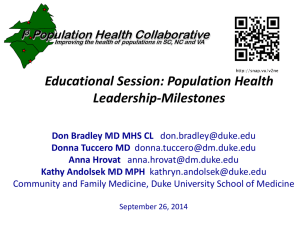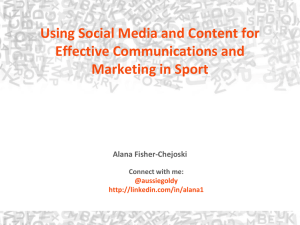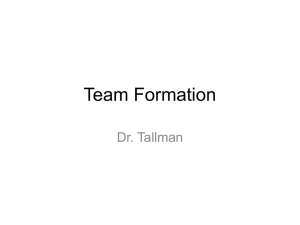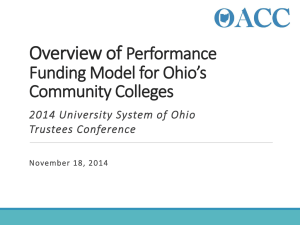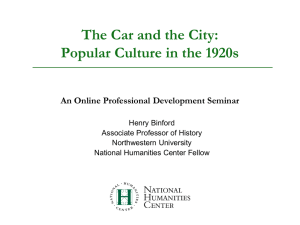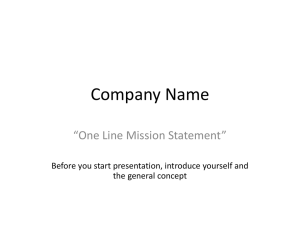Gross Motor Milestones
advertisement
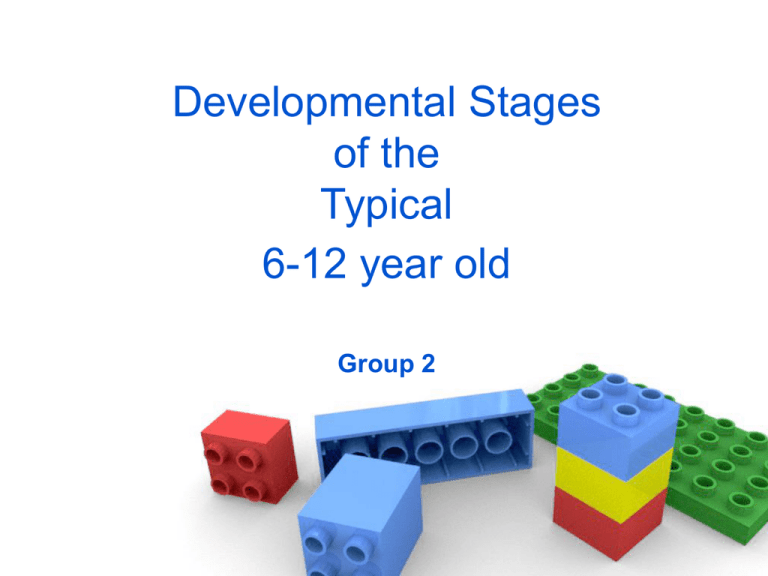
Developmental Stages of the Typical 6-12 year old Group 2 6 years Gross Motor Milestones • Hops, skips, jumps, throws and catches ball • Constantly on the go lugging, tugging, digging, dancing, climbing, pushing and pulling • Try activities that exceed their abilities (i.e.: swinging too high, building too tall) 6 years Gross Motor Milestones • Seems less coordinated than previous year, awkwardness may cause accidents (i.e.: falls out of chair while eating, knocks over glass, etc.) 6 years Fine Motor Milestones • Increased control in hand use • Increased speed and dexterity • Master printing and work on cursive • Copies designs, shapes, letters & numbers • Mature pre hension patterns • Manages buttons, zippers, laces & other closures • Ties a knot and bow • Prints name 6 years Fine Motor/ADL’s • Independent with all basic self care • Begin chores (i.e.: help with cooking, laundry, sweeping, dusting, making bed etc.) 6 years Speech-Language Milestones • • • • • • • • • • • • • Names some letters, numbers and currencies Sequences numbers Understands Left/Right Uses increasingly more complex descriptions Engages in conversations Receptive vocabulary of ~20,000 words Sentence length ~ 6 words Understands most time concepts Recites alphabet Rotely counts to 100 Uses morphologic markers appropriately Uses passive voice appropriately Speech is intelligible 6 years Cognitive Milestones • Begins to demonstrate concrete operational thinking 6 years Social-Emotional Milestones • Feels one way only about a situation; has some difficulty detecting intentions accurately in situations where damage occurs 7 years Gross Motor & Fine Motor Milestones • • • Gross Motor Achieves an adult reaching strategy Execute multiple small movement strategies (early braking) when reaching for an object Monitor their movements in a closed loop strategy to control their reaching • • • • • • • • • • Fine Motor/ADL’s Prints many words Writes in cursive Draws detailed pictures Manages dexterity tasks (i.e.: playing piano, stringing small beads, fastens necklace) Draws 3 interlocking circles Ties shoe laces Measures ingredients & uses simple kitchen utensils Squeezes toothpaste on toothbrush Brushes teeth independently Starts flossing teeth independently 7 years Speech-Language Milestones • Should have mastered the consonants: s, z, r, th, ch, wh and the soft g (i.e.George) • Understands opposites • Tells time to the quarter hour • Complete simple reading • Can write or print many words • Understands terms such as: alike, different, beginning, end, etc. 7 years Cognitive Milestones • Begins to use some rehearsal strategies to aid memory; better able to play strategy games; may demonstrate conservation of mass and length • Simple planning and inhibition—ability to resist distraction 7 years Social Emotional Milestones • May express 2 emotions about one situation, but these will be same valence; understands gender constancy 8 years Gross & Fine Motor Milestones Gross Motor • Jumps rope skillfully • Throws and bats a ball more skillfully • • • • • • Fine Motor/ADL’s Makes lunch Cleans room Packs school bag Draws vertical diamond Cuts things with a knife Plays a game requiring considerable FM skill and good reaction time 8 years Speech-Language Milestones • Complex/compound sentences used with ease • Should be a few lapses in grammatical construction (i.e.: tense, pronouns, plurals • All sounds, including blends, should be established • Reading with considerable ease • Writing simple compositions-better spelling • Control rate, pitch and volume of voice • Carries on adult conversation • Follows fairly complex directions with little repetition • Well developed time and number concepts 8 years Cognitive Milestones • Difficulty judging is a passage is relevant to a specific theme 8 years Social-Emotional Milestones • Understands that people may interpret situation differently but thinks this is due to different information 9 years Gross Motor Milestones • Combine strategies to increase efficiency of movements in order to reduce attention required • Master fine timing adjustments to perturbations • Continue to use closed loop reaching strategy which inhibits the ability to execute anticipatory adjustments and minimize error 9 years Fine Motor/ADL’s Milestones • Can draw a circle made of 8 dots • Enjoys hobbies requiring high levels of FM skills (i.e.: sewing, model building) 9 years Speech-Language Milestones • • • • • • • Listens attentively in group situations Understands grade level material Speaks clearly in an appropriate voice Asks and responds to questions Participates in conversations and group discussions Uses subject related vocabulary Stays on topic, uses appropriate eye contact and takes turns in conversation • Summarizes a story accurately • Explain what has been learned 9 years Cognitive Milestones • May demonstrate conservation of weight 9 years Social-Emotional Milestones • Can think about own thinking or another person’s thinking but not both at the same time 10 years Gross & Fine Motor Development • Gross Motor • Jumping distance continues to increase • Fine Motor 10 years Speech-Language Milestones • Becomes a more sophisticated speller 10 years Cognitive Milestones • Makes better judgments about relevance of a text • Begins to delete unimportant information when summarizing • Hypothesis testing and impulse control reaches adult levels 10 years Social-Emotional Milestones • Can take own view and view of another as if a disinterested third party 11 year old Gross & Fine Motor Milestones • Gross Motor • Running speed stabilizes for girls • Fine Motor 11 years Speech-Language Milestones • • • • • • • • • • • Forms opinions based on evidence Listen for specific purposes Listens and understands info. presented by others Uses words appropriately in conversation Understands some figurative language Gives accurate directions to others Summarizes & restates ideas Organizes info. for clarity Uses subject area info. & vocabulary for learning Make effective oral presentations Follows written directions 11 years Speech-Language Milestones • Takes brief notes • Learns meanings of synonyms and multiple meaning words • Use reference materials • Explain author’s purpose and writing style • Make inferences • Paraphrase • Write effective stories and explanations • Develop a plan for writing • Edit for grammar, punctuation and spelling 11 years Cognitive Milestones • May demonstrate conservation of volume 11 years Social-Emotional Milestones • Still has trouble detecting deception • Spends more time with friends 12 year old Gross & Fine Motor Milestones • Gross Motor • Plays ball more skillfully due to improved reaction time • Fine Motor 12 years Speech-Language Milestones • Maintain eye contact and use gestures, facial expressions and appropriate voice during group presentations • Participate in class discussions across subject areas • Summarize main points • Report about info. gathered in group tasks • Learn meanings of unfamiliar words through knowledge of root words, prefixes and suffixes • Prioritize info. according to the purpose of reading 12 years Speech-Language Milestones • • • • • • • Describe development of character and plot Describe characteristics of poetry Analyze author’s language and style Use reference materials to support opinions Writes for a variety of purposes Vary sentence structure Revise writing for clarity 12 years Cognitive Development • Shows skill in summarizing and outlining • Improvements in goal setting • Verbal design and fluency, motor sequencing & planning emerging • Increased inhibition • Increased verbal memory • Short term memory reaches adult levels 12 years Social-Emotional Milestones Typical Developmental Skills 6-12 year olds References • • • • • • • Asha.org(American Speech and Hearing Association) www.brightfutures.aap.org(American Academy of Pediatrics) Ames, LB, Gillespie, C, Hayines, J & Ilg, FL. The Gesell Institute’s Child from One to Six: Evaluating the Behavior of the Preschool Child. New York. Harper & Row, 1979. Campbell, S. Vander Linden, D, & Palisano, R. Physical Therapy for Children. Missouri:Saunders Elsevier, 2006. Effgen, S. Meeting the Physical Therapy Needs of Children. Philadelphia: F.A. Davis Company, 2005. Schmitz, C, Martin, N, & Assaiante C. Building anticipatory postural adjustments during childhood: A kinematic and electromyographic analysis of unloading in children from 4 to 8 years of age. Experimental Brain Research: 2002. Case-Smith, J; Allen, A; Pratt, P (1996). Occupational Therapy for Children. St. Louis. Mosby, Inc. References • Cech, D; Martin, S (1995). Functional Movement Development Across the Lifespan. Philadelphia. W.B. Saunders • Huizinga M, Dolan CV, van der Molen MW. Age related change in executive function: developmental trends and a latent variable analysis. Neuropsychologia. 2006; 44: 2017-2036. • Capilla A, Romero D, Maestu F, Campo P, et. Al. Emergence and brain development of executive functions, Actas Esp Psiquiatr. 2004; 32 (6): 377-386. • Anderson V. Assessing executive functions in children:biological, psychological and developmental considerations. Pediatric Rehabilitation. 2001;4(3):119-136. • Romine CB, Reynolds CR. Sequential memory: a developmental perspective on its relation to frontal lobe functioning. Neuropsychology Review. 2004;14(1): 43-64. References • Tsujimoto S. The prefrontal cortex:functional development during early childhood. Neuroscientist. 2008;14 Available at http://nro.sagepub.com/cgi/content/abstract/14/4/345-a Accessed March 30, 2009 • Ylvisaker M. Feeney T. Executive functions, self regulation and learned optimism in paediatric rehabilitation: a review and implications for intervention. Ped. Rehab. 2002;5(2)51-70. • Rueda MR, Rothbart MK, McCandliss BD, et.al. Training maturation and genetic influences on the development of executive attention. Porc. Natl. Acad.Sci. U.S.A. 2005;102(41). Available at http://www.pnas.org/content/102/41/14931.long Accessed March 31, 2009

